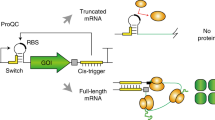Abstract
In this study, we demonstrate that mRNA molecules can serve as an efficient template for cell-free translation through a combination of methods to protect them from nucleolytic digestion. Removal of major endonucleases activity from cell extract, the addition of a stemloop structure at the 3′-end of the mRNA and continuous reloading of ribosomes onto mRNA were found to be crucial for maintaining the functional integrity of mRNA during cell-free synthesis. When these three approaches were combined, mRNA-directed protein synthesis continued over 15 h, leading to the production of 2.6 mg/mL of encoded protein. The methods for direct translation of mRNA presented herein will provide a useful option for deciphering genetic information, including the fields of mRNA display and materialization of metagenomic information.
Similar content being viewed by others
References
Kim, D. M. and C. Y. Choi (1996) A semicontinuous prokaryotic coupled transcription/translation system using a dialysis membrane. Biotechnol. Prog. 12: 645–649.
Yamamoto, Y. I., H. Nagahori, S. Yao, S. T. Zhang, and E. Suzuki (1996) Hollow fiber reactor for continuous flow cell-free protein production. J. Chem. Eng. Jpn. 29: 1047–1050.
Chekulayeva, M. N., O. V. Kumasov, V. A. Shirokov, and A. S. Spirin (2001) Continuous-exchange cell-free protein synthesizing system: Synthesis of HIV-1 antigen Nef. Biochem. Biophys. Res. Commun. 280: 914–917.
Sawasaki, T., Y. Haswgawa, M. Tsuchimochi, N. Kamura, T. Ogawawara, T. Kuroita, and Y. Endo (2002) A bilayer cell-free protein synthesis system for high-throuput screening of gene products. FEBS Lett. 514: 102–105.
Kim, H. C., T. W. Kim, C. G. Park, I. S. Oh, K. Park, and D. M. Kim (2008) Continuous cell-free protein synthesis using glycolytic intermediates as energy sources. J. Microbiol. Biotechnol. 18: 885–888.
Yamaguchi, J., M. Naimuddin, M. Biyani, T. Sasaki, M. Machida, T. Kubo, T. Funatsu, Y. Husimi, and N. Nemoto (2009) cDNA display: A novel screening method for functional disulfide-rich peptides by solid-phase synthesis and stabilization of mRNAprotein fusions. Nucleic Acids Res. 37: 108.
Bowden-Bonnett, L. and J. M. Lord (1979) Isolation and cell-free translation of total messenger RNA from germinating castor bean endosperm. Plant Physiol. 63: 769–773.
Donovan, W. P. and S. R. Kushner (1986) Polynucleotide phosphorylase and ribonuclease II are required for cell viability and mRNA turnover in Escherichia coli K-12. Proc. Natl. Acad. Sci. USA 83: 120–124.
Belasco, J. G. and C. F. Higgins (1988) Mechanisms of mRNA decay in bacteria: A perspective. Gene 72: 15–23.
Kuwano, M., M. Ono, H. Endo, K. Hori, K. Nakamura, Y. Hirota, and Y. Ohnishi (1977) Gene affecting longevity of messenger RNA: A mutant of Escherichia coli with altered mRNA stability. Mol. Gen. Genet. 154: 279–285.
Misra, T. K. and D. Apirion (1979) RNase E, an RNA processing enzyme from Escherichia coli. J. Biol. Chem. 254: 11154–11159.
Taraseviciene, L., A. Miczak, and D. Apirion (1991) The gene specifying RNase E (rne) and a gene affecting mRNA stability (ams) are the same gene. Mol. Microbiol. 5: 851–855.
Lopez, P. J., I. Marchand, S. A. Joyce, and M. Dreyfus (1999) The C-terminal half of RNase E, which organizes the Escherichia coli degradasome, participates in mRNA degradation but not rRNA processing in vivo. Mol. Microbiol. 33: 188–199.
Hirao, I., S. Yoshizawa, and K. Miura (1993) Stabilization of mRNA in an Escherichia coli cell-free translation system. FEBS Lett. 321: 169–172.
Kim, T. W., J. W. Keum, I. S. Oh, C. Y. Choi, C. G. Park, and D. M. Kim (2006) Simple procedures for the construction of a robust and cost-effective cell-free protein synthesis system. J. Biotechnol. 126: 554–561.
Shaw, W. V. (1975) Chloramphenicol acetyltransferase from chloramphenicol-resistant bacteria. Methods Enzymol. 43: 737–755.
Ahn, J. H., H. S. Chu, T. W. Kim, I. S. Oh, C. Y. Choi, G. H. Hahn, C. G. Park, and D. M. Kim (2005) Cell-free synthesis of recombinant proteins from PCR-amplified genes at a comparable productivity to that of plasmid-based reactions. Biochem. Biophys. Res. Commun. 338: 1346–1352.
Kim, T. W., D. M. Kim, and C. Y. Choi (2006) Rapid production of milligram quantities of proteins in a batch cell-free protein synthesis system. J. Biotechnol. 124: 373–380.
Author information
Authors and Affiliations
Corresponding author
Rights and permissions
About this article
Cite this article
Kim, HC., Kwon, YC., Lee, KH. et al. Multi-hour translation of mRNA in a cell-free system. Biotechnol Bioproc E 16, 1152–1156 (2011). https://doi.org/10.1007/s12257-010-0417-0
Received:
Revised:
Accepted:
Published:
Issue Date:
DOI: https://doi.org/10.1007/s12257-010-0417-0




